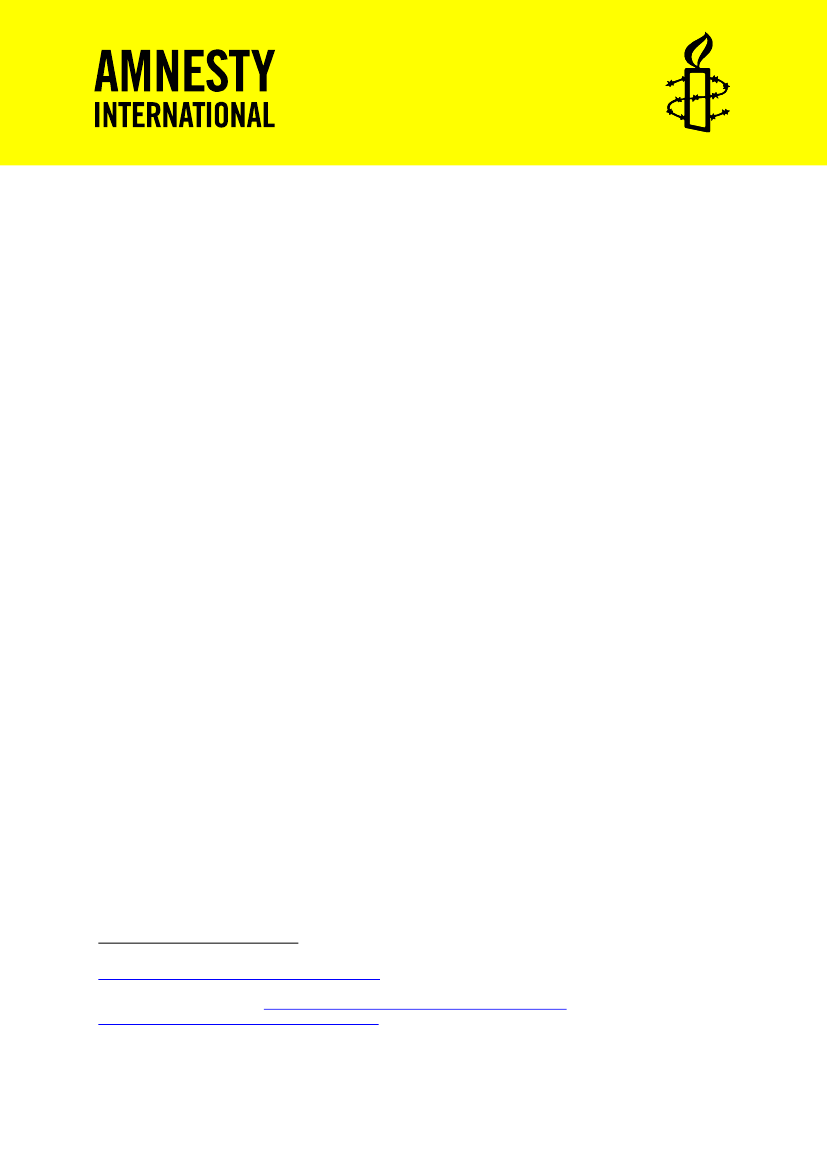Udvalget for Udlændinge- og Integrationspolitik 2012-13
UUI Alm.del Bilag 34
Offentligt
Amnesty International opinion on the
EASO COI Report “Afghanistan: Taliban Strategies – Recruitment”, July 2012
Amnesty International welcomes the decision of the European Asylum Support Office (EASO) toproduce a Country of Origin Information report on Afghanistan to support the EU member states in theirdecisions when assessing application of asylum seekers from Afghanistan. In light of the growingnumber of Afghan asylum seekers in Europe, it is important that the EU member states understand thespecific risks facing Afghans so that more informed and coherent decisions on granting or rejectingasylum of Afghan asylum seekers can be made.The first of the two EASO’s Country of Origin Information reports on Afghanistan entitled “AfghanistanTaliban Strategies – Recruitment” released in July 2012 provides guidelines to assist the work oflawyers, policy-makers and decision-making authorities when dealing with asylum seekers claimingthreats and coercion by the Taleban to join them. However, asperthe UNHCR comment on the EASOreport,1Amnesty International is also concerned that the term “forced recruitment” is defined narrowlyin the EASO report.The EASO report considers “forced recruitment” only in regard to “situations where individuals or theirfamilies are directly approached and forced to join up under threat of retaliation or violence if theyrefuse”. In its conclusion the EASO does not acknowledge the situations of persons joining orsupporting the Taleban as result of indirect methods of intimidation such as through instilling fearamong the local population by threatening night letters, killing individuals, including children,perceived as spies or supporters of the government, the extortion of fines, as well as pressuringindividuals to join the Taleban through tribal, family and religious mechanisms, and other indirectmeans of coercion. Also, in the current context of reintegration and reconciliation efforts with theTaleban, it is expected that more people, including members of ethnic minority groups, may submit toTaleban demands, fearing reprisals.Amnesty International believes that the EASO report conclusion, that the “Forced recruitment byTaliban military commanders, leaders or fighters […] has to be considered as exceptional”, isuntenable.In the light of UNAMA's authoritative report “Afghanistan midyear report 2012 Protection of Civiliansin Armed Conflict”2as well as Amnesty International’s own research, there seems to be a real risk offorced recruitment by Taleban and other armed groups especially in areas under their control andinfluence and government justice mechanisms and services are weak. According to the below findingscases of direct forced recruitment occur in areas other than those considered exceptional in the EASOconclusion.3UNHCR, Forced recruitment by the Taliban in Afghanistan: UNHCR’s perspective, July 2012,http://www.unhcr.org/refworld/docid/4ffc31a32.html2UNAMA, Afghanistan midyear report 2012 Protection of Civilians in Armed Conflict; the report covers the period01 January to 30 June 2012,http://unama.unmissions.org/LinkClick.aspx?fileticket=-_vDVBQY1OA%3d&tabid=12254&language=en-US3According to the EASO report conclusion, example of exceptional cases of direct forced recruitment occur inHelmand, Kunduz, Kunar, areas in Pakistan and in Uruzgan, EASO COI Report, “Afghanistan: Taliban Strategies –Recruitment”, page 42.1
During field research by Amnesty International in 2010 and 2011 internally displaced people (IDPs)stated that one of their reasons for fleeing home areas was the risk and threat of forced recruitment ofmale family members. Many interviewees who fled from the northwest provinces of Badghis and Faryabto the IDP camps in Herat Province told Amnesty International that thousands of the armed men whoare believed to be Taleban were forcefully imposing taxation on families, recruiting the young men toinsurgent groups and killing anyone who opposes them. Also UNAMA observed that there was anincrease of conflict-induced displacement in 2012 and that people displaced from WesternAfghanistan constitute the second largest increase of newly displaced, “due to insecurity, threats,intimidation (such as illegal taxation), and forced recruitment”.4UNAMA also reported that in areas under Taleban control, the Taleban continued to use differentcoercive methods and forms of intimidation against the public, including by holding public meetings,videorecordings, sending night letters to warn people against joining the government. UNAMA alsoreported “the recruitment of opposition fighters, including children”. Also that the Taleban and armedgroups have exploited the rule of law vacuum in remote areas, to enforce their own parallel judicialstructures including to try and/ or punish persons suspected of collaborating with the government andinternational forces, or people suspected of spying for the government and international forces.According to UNAMA, in the first six months of 2012, there was a 53 per cent increase in civiliancasualties as result of targeted killings by armed groups, as Taleban and other armed groups continuedto target community leaders, governmental authorities and civilians suspected of supporting thegovernment or Afghan or international military forces.Also UNAMA’s report found that Taleban and other armed groups have been using civilian houses andfarms in areas of Baghln, Nangahar and Faryab for their protection and for launching attacks. Thisincreases the risk to civilians and the perception of their collaboration with insurgents, and exposesthem to attacks by government and international forces. As in the case of Baghlan province, in theareas controlled by armed groups, UNAMA found that “locals have received night letters ordering themto keep the doors to their houses open at night to accommodate members of the Taleban.”5Additionally, the EASO report should acknowledge the lack of information available from areas underthe Taleban control, since media and humanitarian agencies have restricted access to these areasbecause they have often been accused of spying and been threatened and physically attacked. Hence itshould not be assumed that lack of reporting about forced recruitment means that it does not occur inthese areas, or that if the Taleban are controlling particular areas the population are fully supportingthem. During Amnesty International’s visits to the IDP camps in Kabul, displaced families from theTaleban strongholds in the south told Amnesty International that they had fled attacks by either thegovernment and international forces or the Taleban simply for not supporting them.The EASO report recognizes that children are “especially vulnerable to recruitment in areas wheresocial and state protective mechanisms are absent, such as refugee and IDP locations”. Also it hasbeen acknowledged by human rights and other non-governmental organisations, as well as UnitedNations bodies, that children – mainly male children, although there have been recently reports of girls- are targeted for recruitment as combatants, suicide bombers, porters of munitions and informants byarmed groups such as the Taleban. Most of these cases were reportedly from the border areas withPakistan – the eastern and southern parts of Afghanistan.Amnesty International opposes the recruitment – whether voluntary or compulsory – and participation ofchildren (people under the age of 18) in armed forces whether they are recruited by governments orarmed political groups. Recruitment of children and children participation in hostilities violatesinternational law, including the Additional Protocol II to the Geneva Conventions and the OptionalProtocol II to the Convention on the Rights of the Child.6Afghanistan is state party to both theseUNAMA, Afghanistan midyear report 2012 Protection of Civilians in Armed ConflictUNAMA, Afghanistan midyear report 2012 Protection of Civilians in Armed Conflict6Additional Protocol II to the Geneva Conventions forbids recruitment of children under the age of 15 as well asthem taking part in hostility (Art 4(3)(c)). Optional Protocol II to the Convention on the Rights of the Child raises45
2
protocols. In addition under the statute of the International Criminal Court (Article 8(2)) conscription orenlisting of children under the age of 15 or using them to participate actively in hostilities constitutes awar crime.Decision-makers should take into account the EASO report finding that people from non-Pashtunethnicities such as Uzbek, Tajik and Turkmen have also joined the Taleban ranks due to Talebaninfiltration into non-Pashtun areas. Although Amnesty International does not have information aboutmembers or armed groups of Hazara ethnicity currently joining the Taleban, this possibility should notbe ruled out. In the past representatives of the Hazara ethnic group have joined the Taleban due tofears of reprisals.7Hence, decision-makers should not rule out the possibility of members of otherethnicity groups in Afghanistan joining Taleban due to fear or other methods of coercion.In line with the above and the UNHCR’s comments, Amnesty International urges EU Member Statesnot to define “forced recruitment” narrowly only to situations of direct approach and violence whenassessing asylum claims of forced recruitment. The EASO report conclusion and EU Member Statesshould acknowledge that forced recruitment includes also indirect approaches and coercion that mayprovide plausible grounds for international protection. Moreover, it should be noted that there havebeen reports of forced recruitment using direct approaches and violence in areas other than those listedin the EASO report conclusion as described above.When assessing claims of forced recruitment therefore, EU Member States must take into accountwhether such other methods have been used, as those described further above. The particularvulnerabilities of each individual must be assessed, as well as the state protection mechanismsavailable in the claimant’s area. Every individual should have his/her situation assessed on a case-by-case basis.With regard to assessing the international protection needs of children claiming risks to be recruited bythe Taleban, the focus should be not on whether or not there is a real risk of “forced” recruitment for achild, but whether there is a real risk that the child will be recruited.Furthermore, Amnesty International opposes the forcible return of any Afghan rejected asylum-seeker tothe southern and south-eastern regions of Afghanistan. Due to the ongoing internal armed conflict inthis region, Amnesty International considers that there is no way to ensure that returns to this regioncan be safe for any individual. Southern and south-eastern parts of Afghanistan are largely affected bythe conflict with no or very limited access by aid agencies including UN aid convoys; schools andhealth clinics have been shut down or are operating with limited resources and capacity. There isconstant displacement of people from these areas due to the conflict and the destruction of propertiesand livelihoods. Civilians in the southern and south-eastern regions are at increased risk of targetedkillings, indiscriminate Taleban attacks including suicide attacks, improvised explosive devices (IEDs),or disproportionate air strikes by the international forces.
the minimum age from 15 to 18 years for direct participation in hostilities, for compulsory recruitment by statesand for any recruitment by non-governmental armed groups; Article 4 states that non-state armed groups shouldnot recruit or use in hostilities persons under the age of 18 years.7See Amnesty International, Afghanistan: Thousands of civilians killed following Talebantakeover of Mazar-e Sharif, 3 September 1998 (AI Index: ASA 11/07/98); Amnesty International , Afghanistan:Making human rights the agenda, 1 November 2001 (ASA 11/023/2001),http://amnesty.org/en/library/info/ASA11/023/2001/en
3



